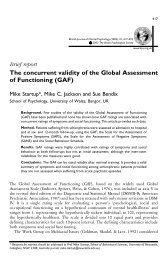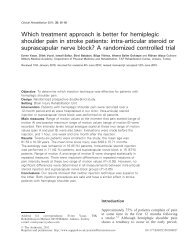Predictive validity of the Hendrich fall risk model II in an acute ...
Predictive validity of the Hendrich fall risk model II in an acute ...
Predictive validity of the Hendrich fall risk model II in an acute ...
Create successful ePaper yourself
Turn your PDF publications into a flip-book with our unique Google optimized e-Paper software.
<strong>an</strong>o<strong>the</strong>r geriatric unit <strong>of</strong> <strong>the</strong> Teach<strong>in</strong>g Hospital at <strong>the</strong> end <strong>of</strong><br />
J<strong>an</strong>uary <strong>an</strong>d <strong>the</strong> research protocol could not be followed as<br />
previously decided, <strong>the</strong> study stopped after 8 months, even<br />
if a longer survey period had been pl<strong>an</strong>ned.<br />
The patients were screened with HFRM <strong>II</strong> at <strong>the</strong><br />
moment <strong>of</strong>, or at <strong>the</strong> most with<strong>in</strong> 24 h upon, admission<br />
at <strong>the</strong> geriatric unit by <strong>the</strong> tra<strong>in</strong>ed nurses.<br />
The patients were followed-up from <strong>the</strong>ir admission<br />
until <strong>the</strong>ir first <strong>fall</strong>, discharge, death or tr<strong>an</strong>sfer to <strong>an</strong>o<strong>the</strong>r<br />
unit, <strong>an</strong>d <strong>fall</strong>s were reported on <strong>the</strong> appropriate <strong>fall</strong><br />
<strong>in</strong>cident report form. We def<strong>in</strong>ed a <strong>fall</strong> as ‘‘<strong>an</strong> event which<br />
results <strong>in</strong> a person com<strong>in</strong>g to rest <strong>in</strong>advertently on <strong>the</strong><br />
ground or floor or o<strong>the</strong>r lower level’’ (Hauer et al., 2003).<br />
The <strong>in</strong>ter-rater reliability was evaluated <strong>in</strong> <strong>the</strong> first<br />
period <strong>of</strong> <strong>the</strong> research. Two nurses applied consequently<br />
<strong>an</strong>d <strong>in</strong>dependently <strong>the</strong> <strong>Hendrich</strong> <strong>II</strong> Model to a convenience<br />
sample <strong>of</strong> older patients admitted to <strong>the</strong> unit dur<strong>in</strong>g <strong>the</strong><br />
first 2 weeks <strong>of</strong> <strong>the</strong> study.<br />
The time <strong>of</strong> adm<strong>in</strong>istration was evaluated ask<strong>in</strong>g all<br />
nurses to estimate <strong>the</strong> me<strong>an</strong> time needed to fill <strong>in</strong> <strong>the</strong> <strong>risk</strong><br />
assessment tool after <strong>the</strong> rout<strong>in</strong>e assessment <strong>of</strong> <strong>the</strong><br />
patients at <strong>the</strong> admission.<br />
2.5. Statistic <strong>an</strong>alysis<br />
Descriptive statistics were used for demographic data.<br />
To measure <strong>the</strong> reproducibility <strong>of</strong> results by more th<strong>an</strong> one<br />
rater, <strong>the</strong> <strong>in</strong>ter-rater agreement was calculated us<strong>in</strong>g<br />
kappa <strong>in</strong>dex at 95% CI. The likelihood <strong>of</strong> older patients to<br />
<strong>fall</strong> was exam<strong>in</strong>ed creat<strong>in</strong>g a 2 2 table to record patients<br />
with high <strong>an</strong>d low <strong>risk</strong> who fell or did not <strong>fall</strong> <strong>an</strong>d <strong>the</strong><br />
predictive <strong>validity</strong> was tested calculat<strong>in</strong>g sensitivity,<br />
specificity, predictive positive (PPV) <strong>an</strong>d negative values<br />
(NPV). The sensitivity was calculated divid<strong>in</strong>g <strong>the</strong> numbers<br />
<strong>of</strong> patients with high <strong>risk</strong> scores who fell by <strong>the</strong> total<br />
number <strong>of</strong> patients who fell, <strong>an</strong>d specificity divid<strong>in</strong>g <strong>the</strong><br />
numbers <strong>of</strong> patients with low <strong>risk</strong> scores who did not <strong>fall</strong><br />
by <strong>the</strong> total number <strong>of</strong> patients who did not experience a<br />
<strong>fall</strong>. The PPV was calculated divid<strong>in</strong>g <strong>the</strong> number <strong>of</strong> older<br />
patients with high <strong>risk</strong> score by <strong>the</strong> total number <strong>of</strong><br />
patients with high <strong>risk</strong> scores, while <strong>the</strong> NPV divid<strong>in</strong>g <strong>the</strong><br />
number <strong>of</strong> patients with low-<strong>risk</strong> scores who did not <strong>fall</strong> by<br />
<strong>the</strong> number <strong>of</strong> patients with low <strong>risk</strong> score. Associated 95%<br />
CIs were also reported.<br />
A receiver operat<strong>in</strong>g characteristic (ROC) <strong>an</strong>alysis was<br />
also carried out to exam<strong>in</strong>e <strong>the</strong> relationship between<br />
sensitivity <strong>an</strong>d specificity <strong>of</strong> <strong>the</strong> tool for different cut po<strong>in</strong>ts<br />
<strong>in</strong> order to determ<strong>in</strong>e <strong>the</strong> optimal cut<strong>of</strong>f po<strong>in</strong>t. Moreover<br />
we calculated <strong>the</strong> <strong>in</strong>cidence rate ratio dur<strong>in</strong>g <strong>the</strong> period <strong>of</strong><br />
study, <strong>an</strong>d <strong>the</strong> <strong>fall</strong> <strong>in</strong>dex <strong>in</strong>cidence ratio for days <strong>of</strong> hospital<br />
stay; to evaluate <strong>the</strong> <strong>risk</strong> factors that ma<strong>in</strong>ly affected <strong>the</strong><br />
<strong>fall</strong>s we calculated <strong>the</strong> odds ratio for each <strong>risk</strong> factor<br />
considered <strong>in</strong> <strong>the</strong> tool.<br />
The data was <strong>an</strong>alyzed us<strong>in</strong>g SAS V9.0 for W<strong>in</strong>dows<br />
(SAS Inc., Cary, NC, USA) <strong>an</strong>d P < 0.05 was considered<br />
statistically signific<strong>an</strong>t.<br />
2.6. Ethical considerations<br />
We asked <strong>the</strong> authorization to perform <strong>the</strong> study to <strong>the</strong><br />
Teach<strong>in</strong>g Hospital General M<strong>an</strong>ager. The study protocol<br />
D. Ivziku et al. / International Journal <strong>of</strong> Nurs<strong>in</strong>g Studies 48 (2011) 468–474 471<br />
was reviewed <strong>an</strong>d approved by <strong>the</strong> University Hospital<br />
Review Board. At admission nurses gave patients, or <strong>the</strong>ir<br />
relatives if <strong>the</strong> patients were unable to decide for<br />
<strong>the</strong>mselves, a brief description <strong>of</strong> <strong>the</strong> aim <strong>of</strong> <strong>the</strong> study,<br />
its <strong>risk</strong> <strong>an</strong>d benefits, assur<strong>in</strong>g that, <strong>in</strong>dependently <strong>of</strong><br />
participation consent or tool scores, <strong>the</strong> best nurs<strong>in</strong>g care<br />
was go<strong>in</strong>g to be provided dur<strong>in</strong>g <strong>the</strong>ir hospital stay. As <strong>the</strong><br />
ma<strong>in</strong> aim <strong>of</strong> <strong>the</strong> study was a tool validation <strong>an</strong>d posed only<br />
m<strong>in</strong>imal <strong>risk</strong> for patients only oral consent was requested,<br />
as approved by review board. Anonymity <strong>an</strong>d confidentiality<br />
was guar<strong>an</strong>teed, all <strong>the</strong> patients’ forms were retrieved<br />
<strong>in</strong> <strong>the</strong> unit daily by pr<strong>in</strong>cipal researcher <strong>an</strong>d stored <strong>in</strong> a<br />
closed box. Dur<strong>in</strong>g <strong>the</strong> data <strong>an</strong>alysis each patient was<br />
identified with a progressive number <strong>an</strong>d only <strong>the</strong> ma<strong>in</strong><br />
researcher could go back to <strong>the</strong> identification <strong>of</strong> <strong>the</strong><br />
patients.<br />
3. Results<br />
3.1. Inter-rater reliability<br />
Dur<strong>in</strong>g <strong>the</strong> first 2 weeks <strong>of</strong> <strong>the</strong> study 24 elderly patients<br />
were admitted <strong>an</strong>d <strong>the</strong> <strong>in</strong>ter-rater reliability was estimated<br />
on <strong>the</strong>m. The kappa <strong>in</strong>dex was 0.87 (95% CI 0.71–<br />
1.00).<br />
Disagreements ma<strong>in</strong>ly concerned <strong>the</strong> classification <strong>of</strong><br />
patients as depressed, <strong>the</strong> presence <strong>of</strong> dizz<strong>in</strong>ess, <strong>an</strong>d <strong>the</strong><br />
use <strong>of</strong> benzodiazep<strong>in</strong>es (used at home, but not dur<strong>in</strong>g <strong>the</strong><br />
first 24 h <strong>of</strong> hospital stay).<br />
3.2. Time <strong>of</strong> adm<strong>in</strong>istration<br />
The average time needed to collect <strong>the</strong> data to fill <strong>in</strong> <strong>the</strong><br />
tool was about 1 m<strong>in</strong>, as estimated by each nurse: <strong>in</strong> fact,<br />
some <strong>in</strong>formation could be retrieved easily from <strong>the</strong><br />
cl<strong>in</strong>ical record or ask<strong>in</strong>g <strong>the</strong> patients or relatives dur<strong>in</strong>g <strong>the</strong><br />
nurs<strong>in</strong>g assessment at <strong>the</strong> admission. The time needed to<br />
perform <strong>the</strong> get up <strong>an</strong>d go test was variable, depend<strong>in</strong>g on<br />
<strong>the</strong> cl<strong>in</strong>ical general conditions <strong>of</strong> <strong>the</strong> patients <strong>an</strong>d<br />
associated diseases. Sometimes was not performed specifically,<br />
because <strong>the</strong> nurse observed <strong>the</strong> patients dur<strong>in</strong>g <strong>the</strong><br />
exam<strong>in</strong>ation <strong>an</strong>d how she/he moves <strong>in</strong> <strong>the</strong> room.<br />
3.3. Population<br />
A total <strong>of</strong> 179 patients met <strong>the</strong> <strong>in</strong>clusion criteria <strong>an</strong>d<br />
gave consent to participate dur<strong>in</strong>g <strong>the</strong> 8 months <strong>of</strong> <strong>the</strong><br />
study. Of <strong>the</strong> 179 patients, 74 were male <strong>an</strong>d 105 female.<br />
The me<strong>an</strong> age was 79.47 years (SD 9.5), with female older<br />
th<strong>an</strong> male (81.7 vs 79.8).<br />
3.4. Validity<br />
A total <strong>of</strong> 14 <strong>fall</strong>s were reported on 179 patients, with a<br />
cumulative <strong>in</strong>cidence <strong>of</strong> 7.8%, <strong>an</strong>d a <strong>fall</strong> <strong>in</strong>dex <strong>of</strong> 7.5 per<br />
1000 days <strong>of</strong> hospital stay.<br />
The me<strong>an</strong> score <strong>of</strong> <strong>the</strong> HFRM <strong>II</strong> was 5.78 (SD 3.52, r<strong>an</strong>ge<br />
0–15). Among <strong>the</strong> <strong>risk</strong> factors evaluated by <strong>the</strong> tool, vertigo<br />
(49%), <strong>in</strong>cont<strong>in</strong>ence (48%), depression (46%) <strong>an</strong>d confusion<br />
(32%) were <strong>the</strong> most prevalent <strong>risk</strong> factors screened on <strong>the</strong><br />
elderly (Table 1), consistently with <strong>the</strong> results <strong>of</strong> o<strong>the</strong>r
















